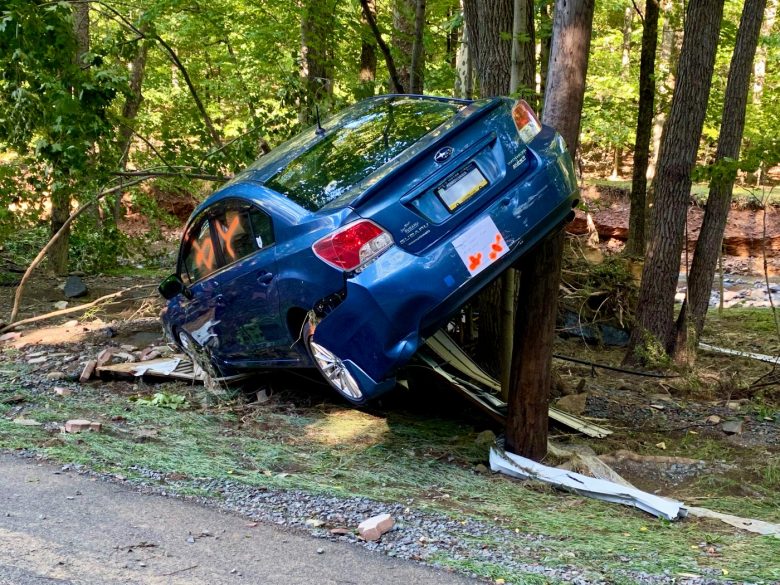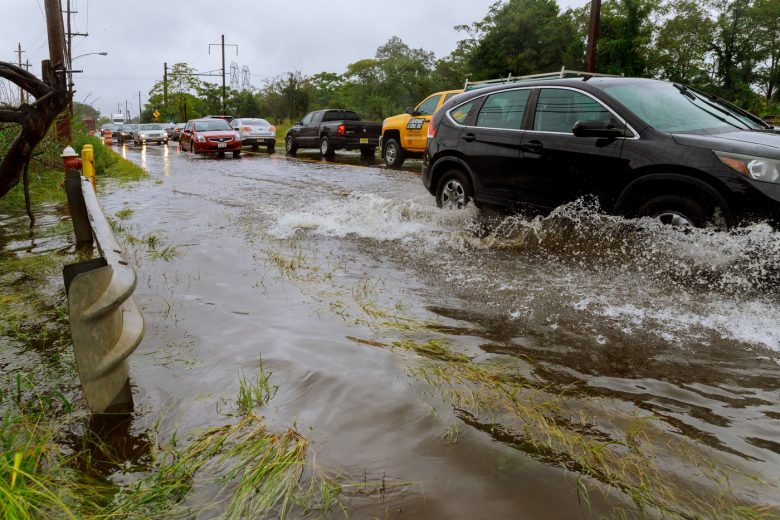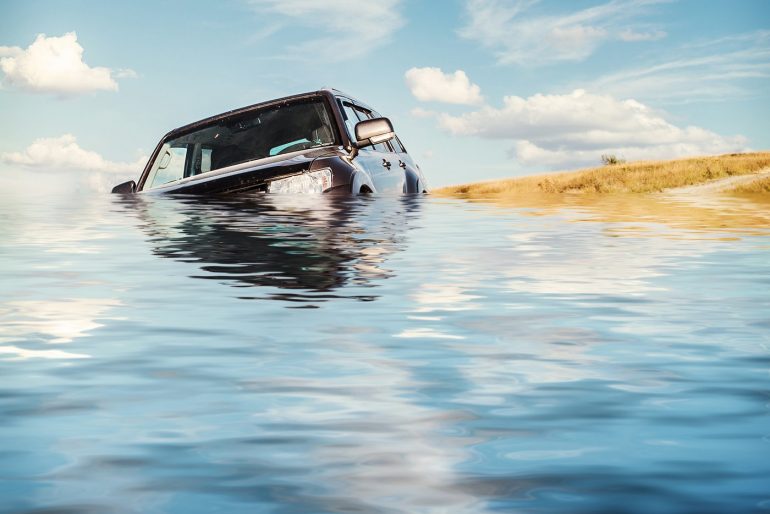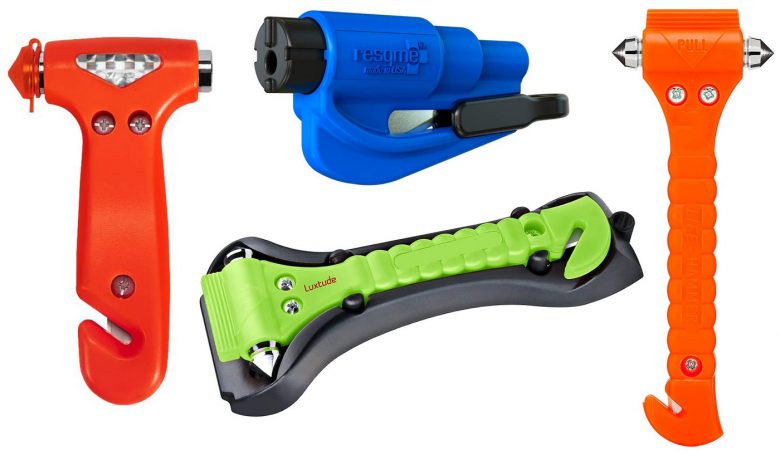Every year, there are several stories in the news about people being trapped in a sinking car during a flash flood or after a vehicle slides into a river — and too often, they don’t survive.
Is there some sinking car survival plan or procedure that could have saved them? What is the best way to escape a sinking car in water or underwater? We have some tips that might help.
How not to be a statistic
In North America, from about 10,000 accidents involving submerged vehicles, about 400 people are estimated to die each year. How is that possible?
One of most preventable causes is due to people driving into flooded areas. As the CDC says, “Vehicles do not provide adequate protection from floodwaters. They can be swept away or may stall in moving water.”
According to the US Federal Emergency Management Agency (FEMA), it doesn’t take a lot of water to potentially create a dangerous situation for you and your vehicle.
- 6 inches: Can reach the bottom of most passenger cars, potentially causing stalling/overall lack of control.
- 12 inches: Can float many vehicles
- 24 inches: If it is rushing water, it can float and carry away most vehicles (not just cars, but also SUVs and pickup trucks)
The NOAA (National Oceanic and Atmospheric Administration) has the “Turn Around, Don’t Drown” campaign, which notes that over half of all flood-related drownings occur when a vehicle is driven into hazardous flood water.
They also offer the following tips:
- If flooding occurs, get to higher ground. Get out of areas subject to flooding. This includes dips, low spots, drainage ditches, canyons, washes, etc.
- Avoid areas already flooded, especially if the water is flowing fast. Do not attempt to cross flowing streams.
- Road beds may be washed out under floodwaters. NEVER drive through flooded roadways — you do not know the condition of the road under the water
Other accidental dangers: But there are other things that can happen, such as sliding off the road, going off a bridge, missing a turn and going down an embankment into a body of water — or simply because the car rolls away after someone forgets to set the parking brake.
Rory Austin of the National Highway Traffic Safety Administration (NHTSA) found that 63 percent of the passenger vehicle drowning fatalities involved a rollover, while 12 percent involved a collision with another motor vehicle. Overall, the most common passenger vehicle crash scenario was a single-vehicle rollover, which accounted for 59 percent of the deaths.

Just get out
Gordon Giesbrecht PhD, from the University of Manitoba in Winnipeg, Canada, conducted several experiments on automobile submersion and lessons in vehicle escape.
His study, published in the August 2010 issue of the scientific journal Aviation, Space and Environmental Medicine, concluded that a vehicle is most easily exited during the initial floating phase — which typically lasts anywhere from 15 seconds to just over a minute — before the water level reached the bottom of the side windows.
(Find out more in this article about Giesbrecht: A Tried and True Approach to Escaping from Sinking Vehicles — And The Guy Behind the Testing.)
As a guideline: Expect that you have 30 to 60 seconds to escape a sinking car. So with the knowledge that your vehicle will probably float for a short time, you should have time to get out before it starts sinking.
Assuming the sinking car hasn’t been severely damaged in the accident that led to its watery predicament, you should have at least a few seconds of battery power left — maybe much more.
This means that you should still be able to create some potential escape routes by rolling down windows, unlocking doors, opening the sunroof, etc. Then unfasten your seat belt and try to get out as quickly as possible through a window.
How to escape sinking car: 8 steps to remember
Giesbrecht and his research partner, Gerren K McDonald, suggested the following easy-to-remember four-step procedure to escape a sinking car:
Step 1: SEATBELT/S: Unfastened immediately
Step 2: WINDOWS: Open
Step 3: CHILDREN: Released from restraints and brought near open window/close to an adult
Step 4: OUT: Push any children out first, then follow
“Everybody knows ‘stop, drop, and roll,’ yet the odds of being in a sinking car are far greater than catching your clothes on fire,” Giesbrecht says.
“In a perfect world, if every kid in North America hears the message ‘Seatbelts, Windows, Out,’ in a generation, we’d be done.”
Removing your seatbelt in a sinking car
There is some contention about when it’s the best time to remove your seatbelt while in a sinking car. From the studies we found specifically relating to automobiles — not helicopters, planes or military vehicles — the advice is to pop your seatbelt and get out as quickly as possible.
In fact, releasing your seat belt should be a key point you remember: many victims have been found still strapped into their cars, even when they had a means to escape. The theory is that panic and disorientation lead some people to forget to unlatch their belts.
“Advocates of staying belted while clearing the glass are putting lives in danger unnecessarily. These advocates are concerned that deepening water will toss the occupants around the cabin resulting in injury, panic, and confusion,” wrote Detective Robert A May of the Indiana State Police Underwater Search and Recovery Team.
“The reality is that if the vehicle is still floating high in the water, the water will not flow over the window opening as the occupants exit. If the opening is below the waterline, the water coming in will not be all that forceful. It is not like a tidal wave.”
And don’t forget about the chill factor. May adds, “An added problem is that the water may be quite cold. Occupants strapped in will be forced to remain relatively stationary in the rising water and lose body heat quickly as the interior fills. Chances are good that panic is setting in. It is better to release the seatbelt immediately and let the survival instinct work to allow a self-rescue through the window.”

But there’s still more: Break your way out of a sinking car
If your vehicle is sinking quickly and you didn’t have a chance to open a door or a window, you still have options.
Step 5: Try breaking a window to get out — but understand that because all vehicles are fitted with strong safety glass, they won’t break easily.
The only devices proven to be effective are spring-loaded window punches or emergency window hammers — and in order for these to be useful at all, they need to be mounted somewhere that you can easily reach from your seat.
(You don’t want to have to look around for it in your glove box or elsewhere in the heat of the moment. I keep mine in the car’s center console, so it can be easily reached from the front or back seats.)
Here are four emergency hammer options, as pictured below.
Clockwise starting from the left:
1. Motorbuddy Auto Emergency Escape Hammer
2. ResQMe, The Keychain Version of the Original LifeHammer
3. Lifehammer Brand Safety Hammer
4. Luxtude Car Window Breaker and Seatbelt Cutter
These all also have seatbelt cutting tools in case your belt is jammed.
Keys, shoes, and even regular claw hammers don’t have nearly as good a chance of getting the job done. Focus your escape efforts on the side windows — particularly the upper corners — and not the windshield, which is laminated and very difficult to break open wide enough for you to evacuate. (Be prepared for a rush of water — potentially very cold water.)
What about the car doors?
As a last resort, you can try to wait until you can open the car doors — but this requires the car filling with water… something that’s incompatible with breathing.
Step 6 (if you need it): Open the door/s as soon as the sinking car is completely filled with water.
If you absolutely can’t exit through the windows, you will have to wait until the car interior is filled with water before you will be able to open a car door. That’s because you need the pressure to be equalized in and out — otherwise, you will be just pushing helplessly against thousands of pounds of pressure, wasting precious time and energy.
(Dr Giesbrecht’s study backs this up — during one exit attempt during the sinking phase, they could not open the doors or windows at all until the vehicle was completely full of water.)
So opening the windows helps the water flow in faster, which could potentially give you a better chance of escaping before your car sinks too deep.
Escape underwater car now, call 911 later
Step 7: Call 911 AFTER you and all passengers have escaped the sinking car.
If your car is submerged or sinking, don’t bother calling 911 for help until you’re out of the car — it will just take time… time that you don’t have to wait for a rescue.
Giesbrecht and McDonald agree, writing, “In the case of vehicle submersion, valuable time is wasted as it likely takes more than 60 seconds to make a cell phone call and provide details and directions; a period that precludes the victim from escaping during the simpler and safer FLOATING Phase.”
They add, “there is no rescue system that guarantees arrival on site within one minute, which would be required to even attempt a successful rescue.”
Always remember your number one objective is to get yourself and your passengers to safety. Assume you’re on your own — and whatever it takes, don’t delay.
Step 8: Stay out!
Finally: Once you’re out, stay out! Never re-enter a sinking or underwater car to get anything except for another person.










